Kristine Hughes's Blog, page 59
May 27, 2016
DO YOU KNOW ABOUT? THE LONDON LIBRARY
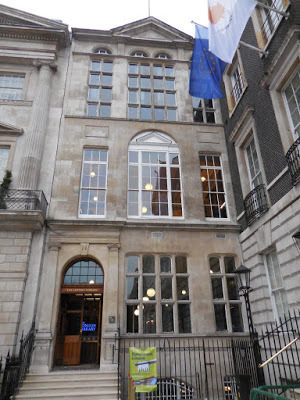 The London Library in St, James Square
The London Library in St, James SquareAaah, the London Library. The Holy Grail of research libraries as far as most historians are concerned. The oh so hard to get into Valhalla of archives. Such is the mystique that has been built up about the Library, one is certain that access into it's hallowed halls is as difficult to attain as a ticket to Almack's had once been. So, when Victoria and I were in London in September over Open Houses Weekend, we put the London Library in St. James's Square at the top of our list. This would be our chance to finally see the inside of this venerable institution. Unfortunately, we didn't know that one had to sign up for the Library tour prior to the date, but the very nice lady at the reception desk invited us to take a seat and to wait for the next tour to start. If the anticipated numbers did not show up, we would be more than welcome to join the group.
So we waited. And we eagerly eyed all who entered. Surely, we'd see the likes of world famous historians, household name authors and mayhap an Oxford don or two. Not a bit of it - everyone who entered the Library looked quite ordinary. Many of them looked to be students. When a pair of particularly young seeming male students walked by, Victoria whispered, "How do you think they got in here?"
"Don't know," I whispered back. "How did any of these people get in here?"
"The entrance fee is supposed to be really expensive, and besides that, you have to provide references. What sort of references could a pair of seventeen year olds have?"
"I think you're making it harder than it really is to get in here. I mean, we have references."
"We do?"
"Yes," I hissed, "of course we do. We're both published authors, aren't we? And we have the blog, which has been up and running on a regular basis for six years now. That should demonstrate a serious academic bent. At the very least it proves that our interest in researching 19th century Britain is more than a passing fancy."
"I don't know," Victoria said, "I think you have to have like three references from people who are already members of the Library."
"Are you sure? Maybe you're confusing it with White's Club."
The next tour group began to form and, miraculously, Victoria and I both got in. Joy! I must say, we really were given a behind the scenes tour: we were shown through many of the rooms and miles of stacks. We went up floor by floor to the attics and down again to the basement, all the while being surrounded by books we longed to get our hands on. The pictures below will give you some idea of the Library's holdings.
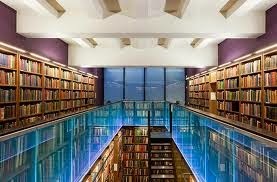
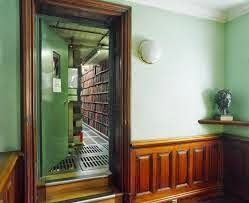
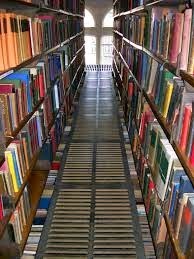
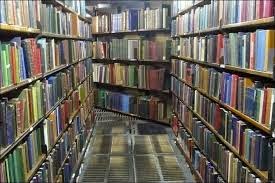
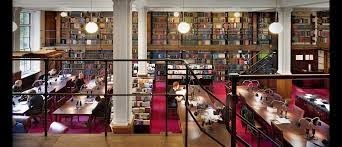
Upon our return to the States, I went online to seriously investigate exactly what membership in the London Library involved. Unsurprisingly, I soon got distracted - the Library has an online catalogue of its holdings called Catalyst, that will not only search for books and journals in the Library, but will also search for titles and in many cases the content of the Library's eJournal and database collections, as well. So, again unsurprisingly, I searched for the Duke of Wellington.
And got 6,614 results.
I also found online guides to various collections: The Food and Drink Collection, A Guide to the French Collections, Guide to the Topography Collections. Many more can be found on the Library's website.
At long last, I got around to the membership page - Individual annual memberships are £485 or forty pounds per month. Victoria was correct, you do need a reference, or Referee, but they do not necessarily have to be a Library member:
Referee: Applicants are asked to give the name of a referee, who should be someone to whom you are known personally (but not someone living at the same address) and whose position can be verified if necessary (e.g. a member of a professional body, an academic, teacher, current member of the Library etc.).
And there are alternatives to an annual membership for those who are just visiting the UK, shown below. Can't wait to let Victoria know - we actually do know several people in the UK who might vet us and we could always split the membership fees and share the online membership. Now it's just a question of how long it will take me to get through over six thousand results for the Duke of Wellington.
Daily and Weekly Tickets

A limited number of temporary tickets are made available for non-members who wish to consult specific material from the Library's collections which is not available in other publicly accessible national, specialist or public librariesDaily tickets £15.00. Weekly tickets £50.00. (Cash or cheque payment only)Advance booking requiredTickets are for reference use of the Library onlyApplicants will need to produce two identification documents – one including a photo (eg passport, driving licence, travel card, student card, ID card) and one including confirmation of their current address (eg driving licence, recent bank statement or utility bill, official letter). Visitors to the UK are required to produce confirmation of their address while in the UK.Contact Book Enquiries in the first instance to enquire about the materials you wish to consult. Contact Reception thereafter to make a booking
Temporary Overseas Visitors Membership

£243.00 for 4 monthsAvailable for visitors from overseas with no permanent address in the United Kingdom. In addition to the subscription fee a deposit of £243.00 is payable on admission, refundable at the expiry of the membership, or earlier, provided that the membership card is surrendered and that all loans have been returned
Published on May 27, 2016 00:00
May 25, 2016
WALKING LONDON WITH SIR IAN McKELLEN
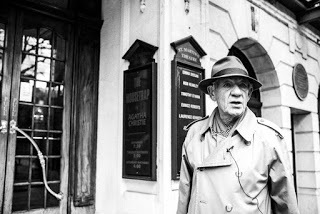

Rediscover the West End on a GPS-guided audio walk with Sir Ian McKellen
Audio tour app VoiceMap has today launched an audio tour through the heart of London’s Theatreland, guided by legendary actor Sir Ian McKellen. The tour gives both Londoners and visitors the unique opportunity to see the West End through McKellen’s eyes, and includes stories of his 52-year-long career on the stage.
Theatreland Tour with Ian McKellen was produced by Official London Theatre – a brand under the not-for-profit Society of London Theatre – and is part of the organisation’s efforts to promote theatregoing. The audio walk can be downloaded free of charge using the VoiceMap apps for iOS and Android devices. These use GPS to play audio automatically, with McKellen directing you through your earphones along the way.
McKellen invites listeners to play the lead role in a one-of-a-kind “performance”, with him as director. The streets of London’s theatre district are the stage, he says, and occasionally McKellen cracks a joke about the listener’s brilliant stage presence, or assigns them an acting test. The tour weaves together tales of theatre’s rich history with McKellen’s own memories, from his West End debut in 1964 at the Duke of York Theatre, to flirting from the art deco windows of the Fortune Theatre in the 1970s, and battling a child while playing Captain Hook – in high heels – in the 1990s.
Starting and ending at the TKTS ticket booth on Leicester Square, the hour long circular walk passes several significant landmarks. Listeners experience Theatreland as it was for actors and audiences 300 years ago, before electric lights and moving sets, when audiences showed their disapproval by throwing fruit at the stage. The walk takes in Bow Street Magistrates Court, where Oscar Wilde was sentenced to hard labour for “indecent acts”, and the Savoy Theatre, which was the first public building in the world to be lit entirely by electric lights. Central to the story are the actors, architects and managers who shaped this unique part of London, turning it from one of the city’s most disreputable slums into the glittering heart of British theatre.
Unlike traditional walking tours the app allows participants to explore at their own pace, perhaps stopping for a drink or two along the way. McKellen recommends the Coal Hole pub where Gilbert and Sullivan performed during Edwardian times.
Londoners can also use VoiceMap to create audio tours of their own, assisted by the company’s editors. This is free, and tours can be sold via the app at a price set by the tour creator, with royalties paid on each download.
VoiceMap is a mobile application available on iPhones or Android devices that uses your location to play GPS-activated audio tours automatically. It has a fast-growing catalogue of audio tours in over 50 cities worldwide, many of them by bestselling authors, foreign correspondents, and veteran broadcasters.
Published on May 25, 2016 00:00
May 23, 2016
OPEN CITY DAYS: ROYAL SOCIETY OF ANTIQUARIES
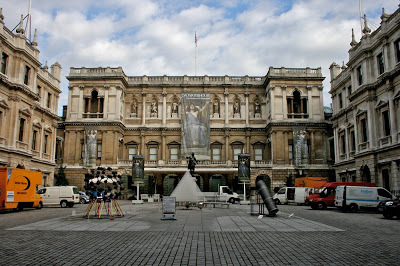
Our next stop along our Open Houses Day route was the Royal Society of Antiquaries, founded in 1707. Today, their 3,000 Fellows include many distinguished archaeologists and art and architectural historians holding positions of responsibility across the cultural heritage. The Fellowship is international in its reach and its interests are inclusive of all aspects of the material past. The Society previously had offices in Somerset House before moving in 1874 to a suite of purpose built apartments in the courtyard of Burlington House, Piccadilly, which offered the Society substantially larger rooms. The Society is also responsible for their Library and Museum collections (at Burlington House and at Kelmscott Manor) and offers conservation and research grant awards, a varied programme of events (lectures and seminars), communications such as publications, a website and e-newsletter.
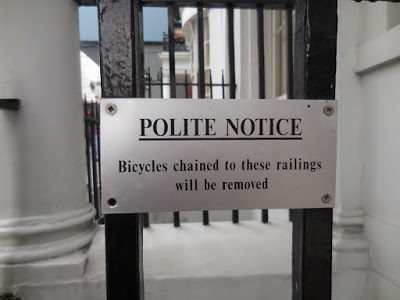
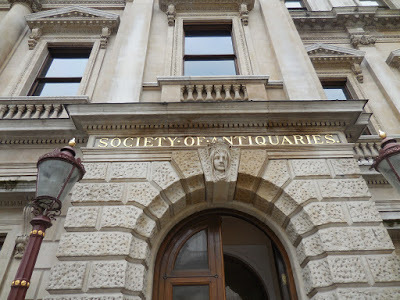
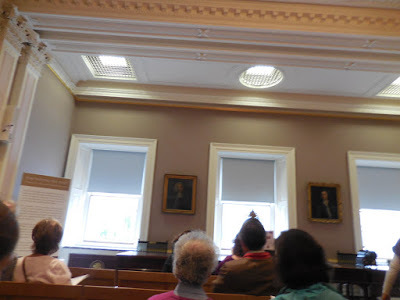
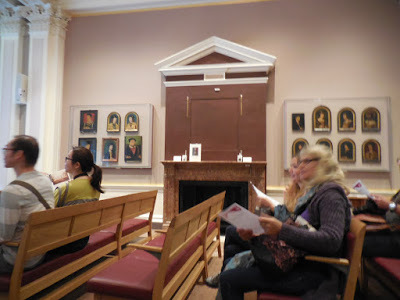
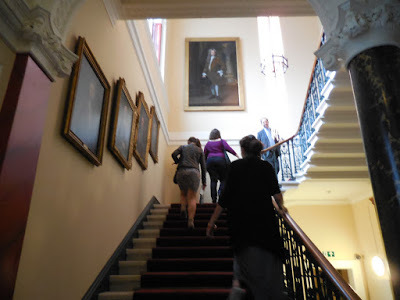
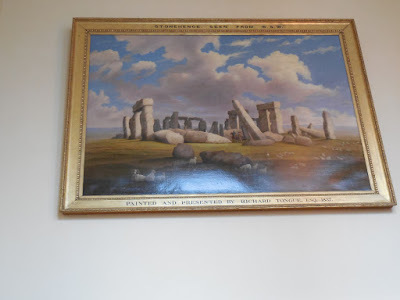
The entire building was filled with fabulous architecture, but you will understand that Victoria and I were both especially interested in the Library.
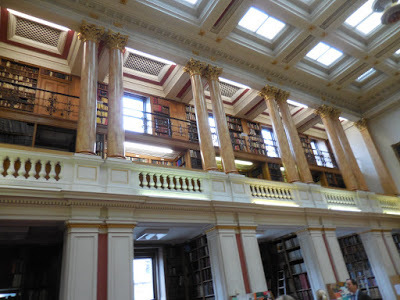
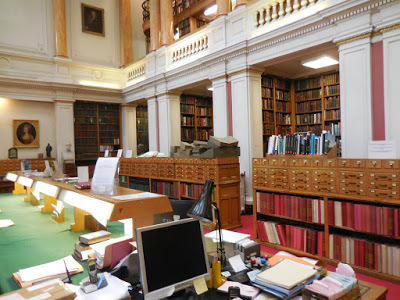
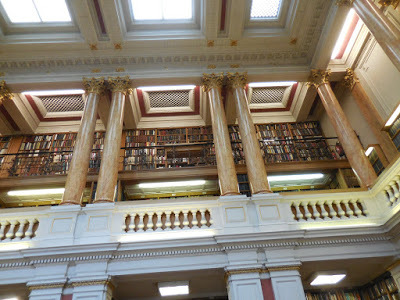
From the Society's website: For 300 years the Library has been at the heart of the Society, helping to shape our understanding of the past. The Library is the largest antiquarian library in the country, with an outstanding collection of more than 130,000 books dating from the fifteenth century to the present day, holdings of historic journals and over 500 current subscriptions, manuscripts and archives, and prints and drawings. It covers British and European archaeology, architectural history, art history and the decorative arts (especially medieval), the historic environment, and British local history. Its collection of county historical and archaeological publications is one of the most comprehensive in the country, as its collection of European journals. Our special collections include 2,000 proclamations from 1464 to the mid-nineteenth century, 1,000 broadsides including a printed indulgence from 1513, the Lowther collection of Civil War tracts, the Fairholt Collection on pageantry, the Prattinton Collection on Worcestershire, the Jackson Collection on Wiltshire, the Willson Collection on Lincolnshire, the archives of the Society of Dilettanti and the Roxburghe Club Library.
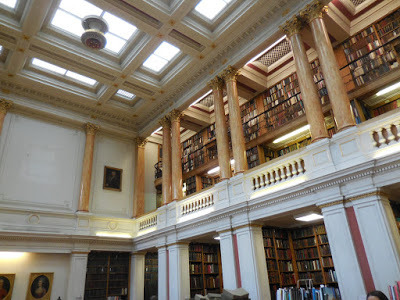
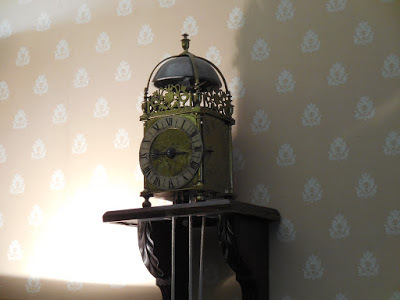
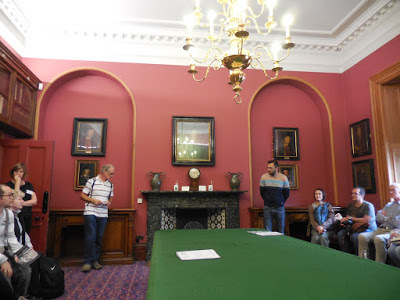
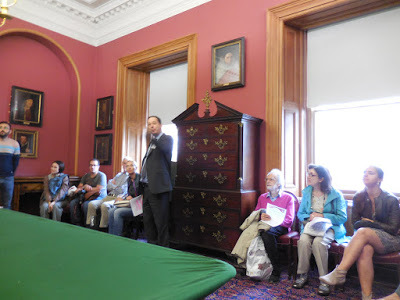
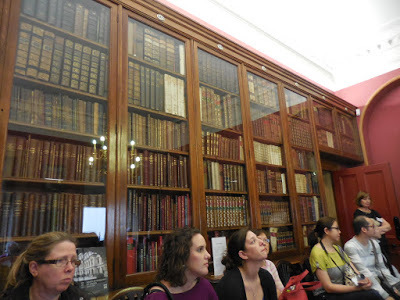
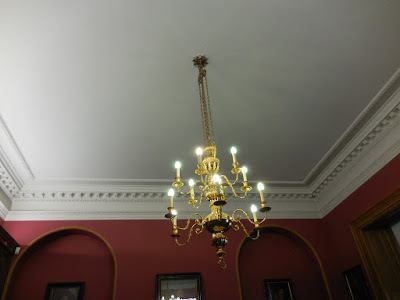
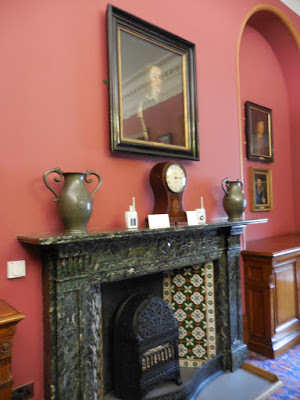
Published on May 23, 2016 00:00
May 20, 2016
LUNCHEON IN PICKERING PLACE AND A VISIT TO LOCK'S HATTERS
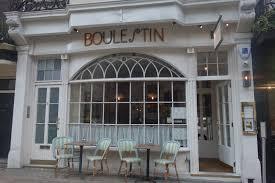
After a busy morning of poking our noses into various London venues, Victoria and I decided to take a much needed pause for lunch at Boulestin in St. James's Street. Boulestin offers an intimate and elegant setting in which to enjoy modern French cuisine. The food is fabulous and the location even better - the site was once occupied by Overton's Restaurant and Oyster Bar and its' outdoor dining tables are in Pickering Place. Yes, that Pickering Place.
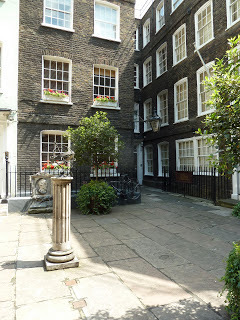
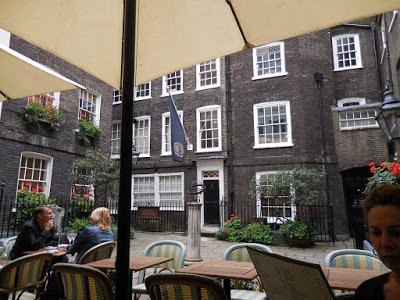
Once our food had been delivered and the wine poured I looked at Victoria and said, "We're eating in Pickering Place."
"I know."
"How cool is this?" I asked.
"Tres."
"Pickering Place."
"Yup. Duels, even."
"Have you heard the story about how the Duke of Wellington came back from Paris incognito in 1816 and thrashed the Hell out of Brummell for being such an idiot and getting himself into debt and insulting Prinny? It happened right here. The Duke was punching the crap out of Brummell when an old woman opened a window on the second floor, right there, and yelled `Begone, ye hooligans!'`And Brummell yelled back, `It's not a hooligan, it's the Duke of Wellington!' And the old woman replied, `And I'm Queen Caroline. Now get away with ye before I call out the Watch.'
"Nope,' Victoria said, "never heard that. Probably because you just made it up. I like it though."
"Yeah, not bad. Do you want to go next door to Lock's and look at the Duke's hat when we're done?"
"Sure. Do you want any of this brie?"
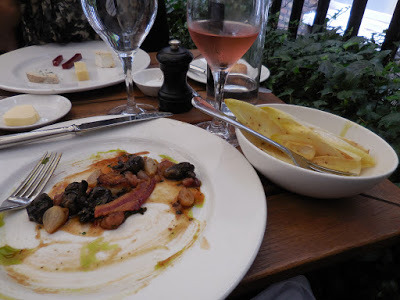
And so we made our way two doors down to Lock's Hatters, where Wellington's bicorn and Nelson's hat, complete with eye patch, are both on display, as are hat forms, order books, letters from famous customers and all other manner of interesting memorabilia.
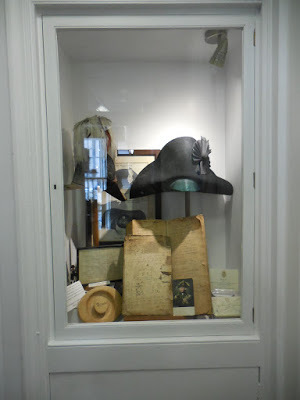
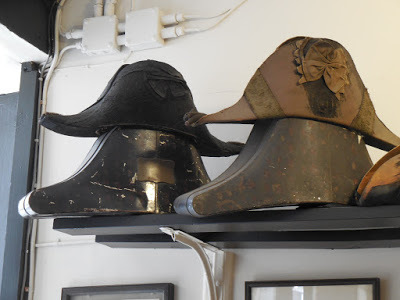
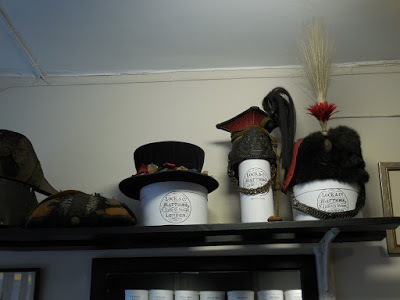
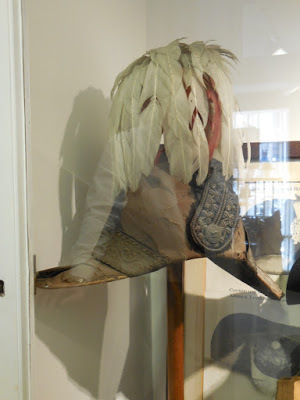
Above, the Duke of Wellington's hat.
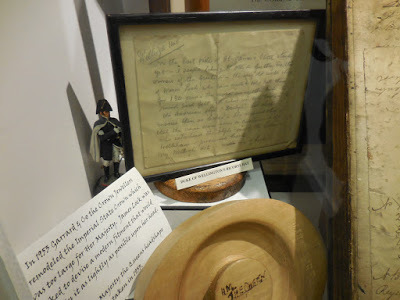
Lock's is the oldest hat shop in the world - founded in 1676 - and has been at it's current St. James's Street location since 1765. Anyone and everyone of note had hats made at Lock's, especially those gentlemen in the military, who hunted or who appeared at Court. Lock's records are a veritible who's who of English society from the Georgian period through to the present day. And whilst Lock's is most associated with gentlemen's hats, they also supply millinery services for ladies, as you can see in this video.
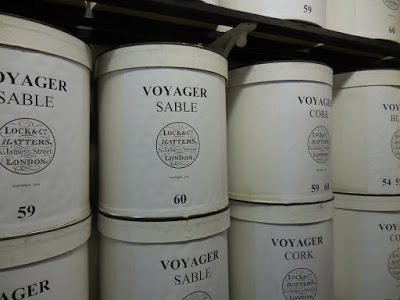
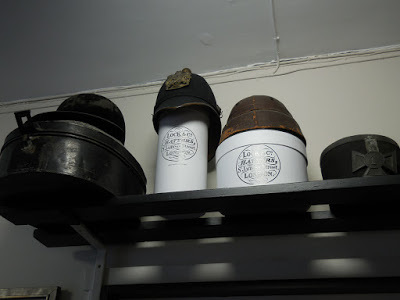
Having just visited Lock's Hatters earlier this month and meeting with current staff, I'm pleased to be able to announce that a visit to the shop will be a feature of several of Number One London's upcoming tours for 2017.
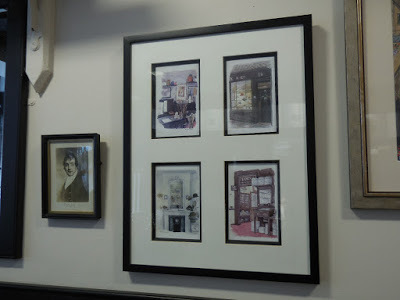
In fact, most of St. James's Street will feature on our tours, where we'll step back in time in order to Research the Regency. In the meantime, stay tuned here for more of Kristine and Victoria's Open House visits.
Published on May 20, 2016 00:00
May 18, 2016
JASNA CHICAGO CELEBRATES SPRING
The morning rain heralded a beautiful Spring day as about 100 JASNA members gathered at the Woman's Athletic Club for the Greater Chicago Region's Spring Gala on Saturday, May 7, 2016.
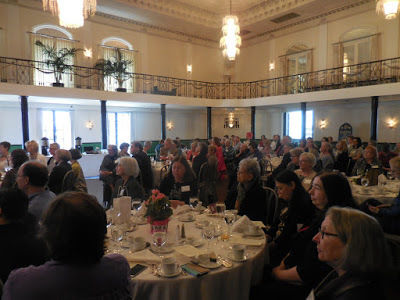
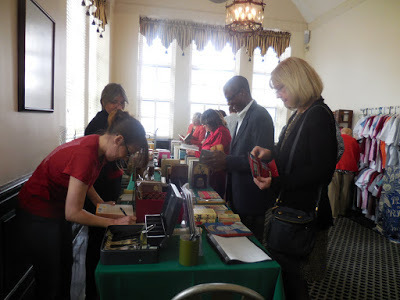 The Emporium was a busy place with Jane Austen Books and other dealers tempting all of us.
The Emporium was a busy place with Jane Austen Books and other dealers tempting all of us.
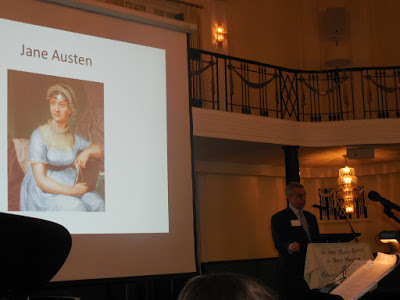 Regional Coordinator Jeffrey Nigro welcomed all of us and introduced the program.
Regional Coordinator Jeffrey Nigro welcomed all of us and introduced the program.
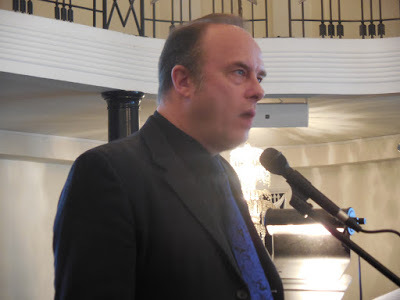 Northwestern University Pianist and Lecturer, Stephen Alltop
Northwestern University Pianist and Lecturer, Stephen Alltop
The morning program was Jane and Emma -- A Celebration of Music and Words by Stephen Alltrop and Josefien Stoppelenburg. They performed selections from music known to have been played by Jane Austen, many from the books of music she herself copied.
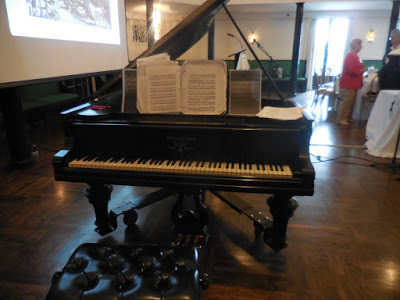 Stephen performed on the elegant Steinway, but due to my corner seat, I couldn't catch him in the act!
Stephen performed on the elegant Steinway, but due to my corner seat, I couldn't catch him in the act!
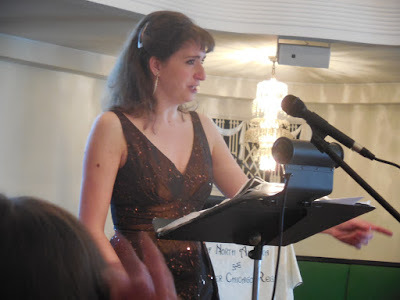 Soprano Ms. Stoppelenburg sang a variety of Austen's favorites, from Italian arias to English folk tunes.
Soprano Ms. Stoppelenburg sang a variety of Austen's favorites, from Italian arias to English folk tunes.
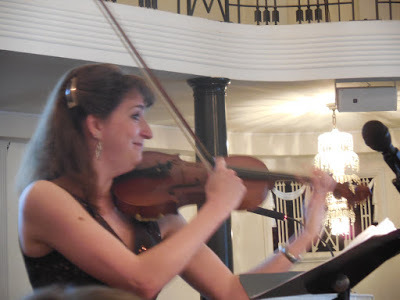 The accomplished soprano also entertained us with her violin.
The accomplished soprano also entertained us with her violin.
Before luncheon, we all had the opportunity to enjoy the varied and delightful centerpieces on the tables, each representing a scene from Emma and creatively assembled by volunteers. Here is a sampling:
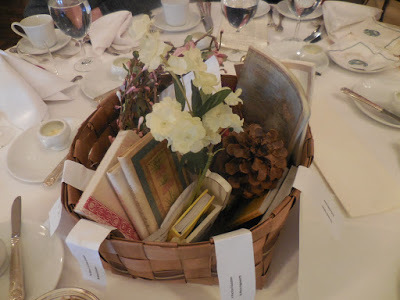
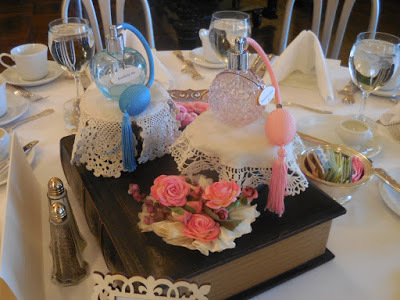
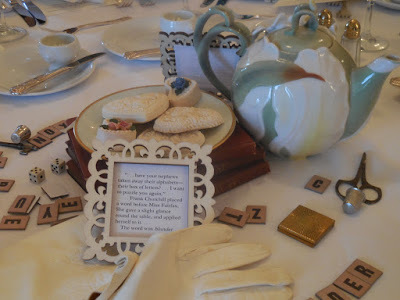
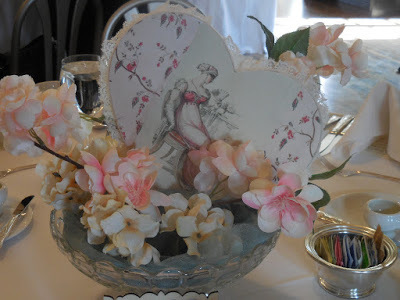
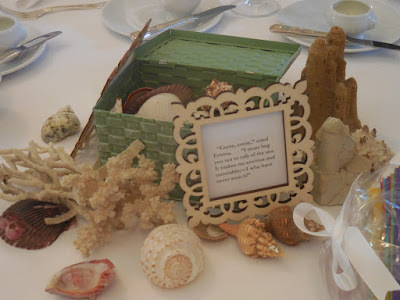
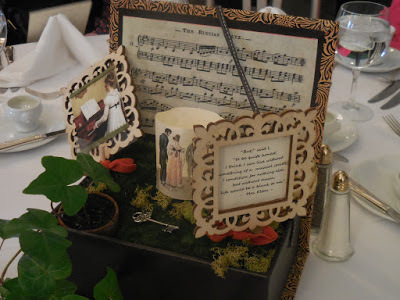
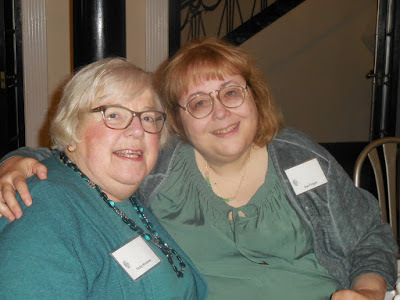 Victoria Hinshaw and Susan Forgue
Victoria Hinshaw and Susan Forgue
After luncheon, Susan Forgue and Victoria Hinshaw presented London High Society in Austen's Novels, including Sue's beautifully made Almack's vouchers.
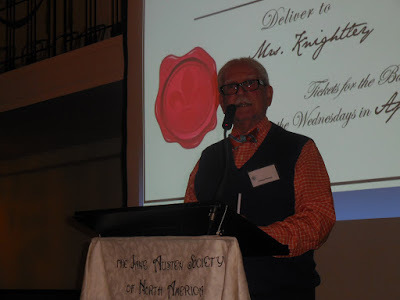 William Phillips in front of the voucher slide!
William Phillips in front of the voucher slide!
The only snag in this delightful day (just kidding of course!) was Quizmaster William Phillips's diabolically difficult questions! Even those of us who thought we KNEW Emma backwards and forwards were often stumped by the obscure facts he found to challenge us! I have to admit we should have been forewarned as this is not the first time William has teased us so mercilessly. Just for that, William, I am showing your picture almost unintelligibly -- also since that is the way it turned out!! Sorry.
Many thanks to Jeffrey Nigro and Program Chair Debra Miller, the Emporium dealers, and all who attended!

 The Emporium was a busy place with Jane Austen Books and other dealers tempting all of us.
The Emporium was a busy place with Jane Austen Books and other dealers tempting all of us. Regional Coordinator Jeffrey Nigro welcomed all of us and introduced the program.
Regional Coordinator Jeffrey Nigro welcomed all of us and introduced the program. Northwestern University Pianist and Lecturer, Stephen Alltop
Northwestern University Pianist and Lecturer, Stephen AlltopThe morning program was Jane and Emma -- A Celebration of Music and Words by Stephen Alltrop and Josefien Stoppelenburg. They performed selections from music known to have been played by Jane Austen, many from the books of music she herself copied.
 Stephen performed on the elegant Steinway, but due to my corner seat, I couldn't catch him in the act!
Stephen performed on the elegant Steinway, but due to my corner seat, I couldn't catch him in the act! Soprano Ms. Stoppelenburg sang a variety of Austen's favorites, from Italian arias to English folk tunes.
Soprano Ms. Stoppelenburg sang a variety of Austen's favorites, from Italian arias to English folk tunes. The accomplished soprano also entertained us with her violin.
The accomplished soprano also entertained us with her violin.Before luncheon, we all had the opportunity to enjoy the varied and delightful centerpieces on the tables, each representing a scene from Emma and creatively assembled by volunteers. Here is a sampling:






 Victoria Hinshaw and Susan Forgue
Victoria Hinshaw and Susan ForgueAfter luncheon, Susan Forgue and Victoria Hinshaw presented London High Society in Austen's Novels, including Sue's beautifully made Almack's vouchers.
 William Phillips in front of the voucher slide!
William Phillips in front of the voucher slide!The only snag in this delightful day (just kidding of course!) was Quizmaster William Phillips's diabolically difficult questions! Even those of us who thought we KNEW Emma backwards and forwards were often stumped by the obscure facts he found to challenge us! I have to admit we should have been forewarned as this is not the first time William has teased us so mercilessly. Just for that, William, I am showing your picture almost unintelligibly -- also since that is the way it turned out!! Sorry.
Many thanks to Jeffrey Nigro and Program Chair Debra Miller, the Emporium dealers, and all who attended!
Published on May 18, 2016 00:00
May 16, 2016
LOOSE IN LONDON: OPEN HOUSE WEEKEND 74 ST. JAMES'S STREET
74 St. James Street is an amazing building, now part of a international bank which has preserved the colorful interior. Victoria here, telling you that Kristine and I could hardly believe our eyes after already visiting three lavish mansions during the 2014 Open City London days...in 2016, the Open weekend will be Saturday and Sunday, September 17 and 18.
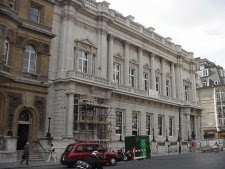 74 St. James Street
74 St. James Street

74 St. James's Street was the site of the old Conservative Club, now dissolved. Construction started in 1843, In 1950 it merged with the Bath Club, and was disbanded in 1981. From 1845 until 1959, the club occupied a building at 74 St James's Street.and although the club moved out a century later, the building went on to be home to McKinsey and Co. in the early 1970s, and now houses the London office of HSBC Private Bank.
Prior to the Conservative Club's occupation of the site, there stood on that corner a range of low buildings derived from the country estate of Sir William Pulteney. The original complex had been converted during the 18th century into shops, taverns and pieds-a-terre. The principal establishment on the site was the Thatched House Tavern, located in the upper stories of the shops lining St. James's Street and set back from the building line so that the roof of the one-story shops formed a balcony overlooking St. James's for the drinkers and as a vantage point for watching special events, such as the Duke of York's funeral procession.
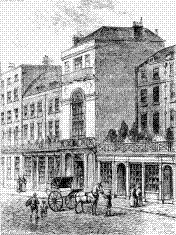
The tavern was much frequented by clubs and societies: the Society of Dilettanti, the Noblemen and Gentlemen's Catch Club and the Royal Yacht Squadron, to name a few. A narrow lane at right angles to St. James's, running through the middle of the site, gave access by a side door to the tavern and led on through to a small court (Thatched House Court) behind it. The Court was of small by pretty houses providing London apartments for people of fashion such as Edward Gibbon, who lived there until his death in 1894.
The new building built on the site by the Conservative Club at a cost of twenty nine thousand pounds was completed in 1845. The proportions of the saloon were injured in 1951 by the removal of the grand staircase, which led out of the middle door
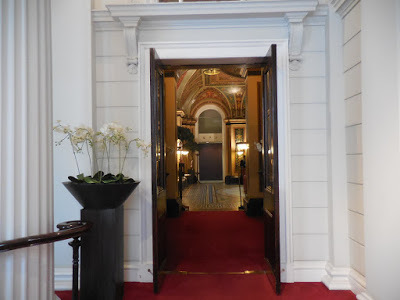 The approach hardly prepared us for the colorful and amazing craftsmanship of the interior.
The approach hardly prepared us for the colorful and amazing craftsmanship of the interior.
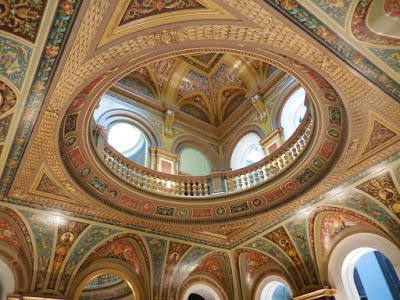
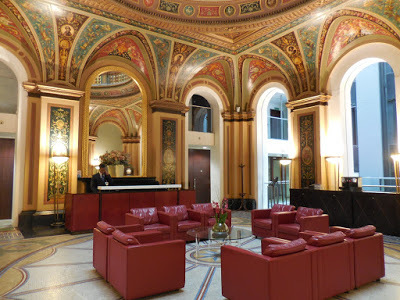
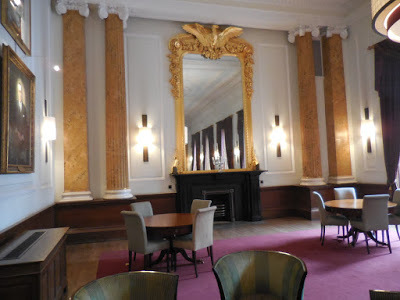
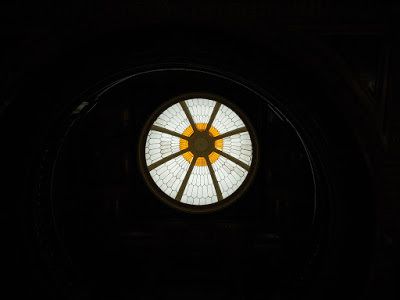
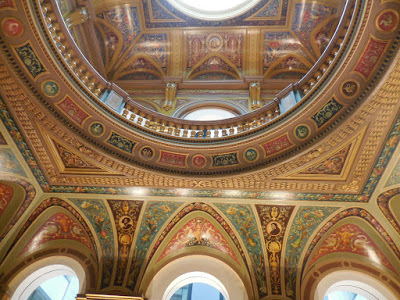
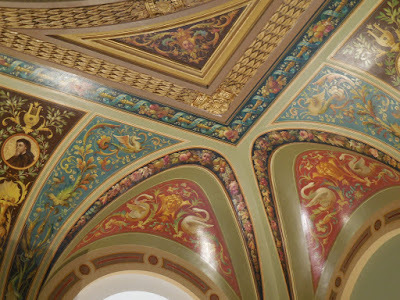
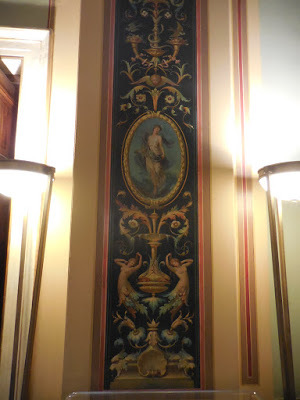
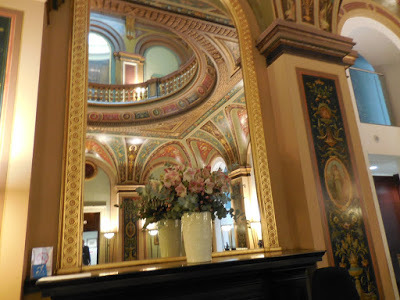
The series of portrait medallions honor the great artists and writers of Britain.
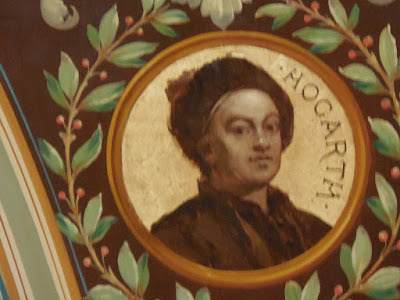
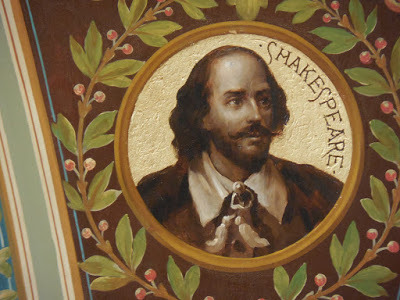
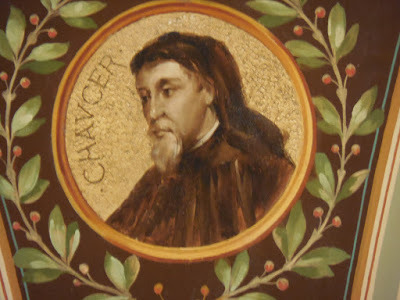
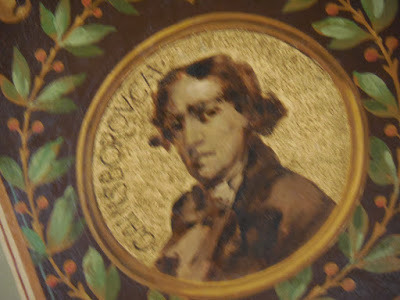
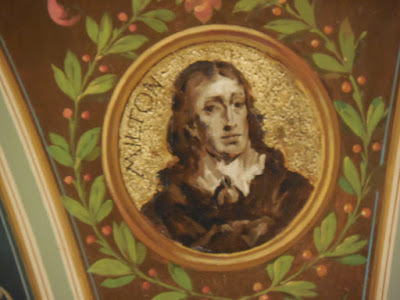
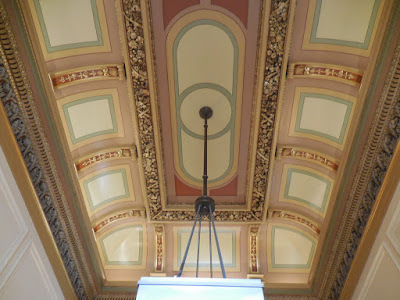
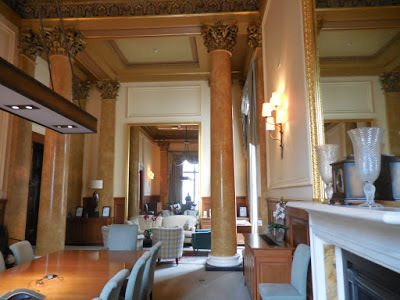
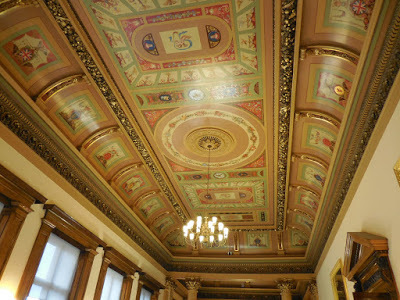 Could you get any work done under this ceiling? I think I would spend my time admiring the workmanship.
Could you get any work done under this ceiling? I think I would spend my time admiring the workmanship.
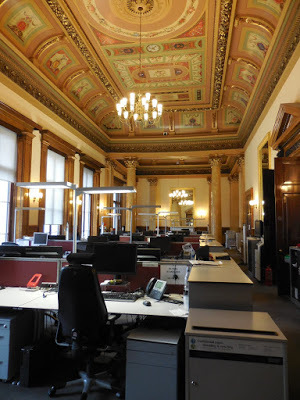 The inevitable mix of modern work areas with Victorian surroundings.
The inevitable mix of modern work areas with Victorian surroundings.
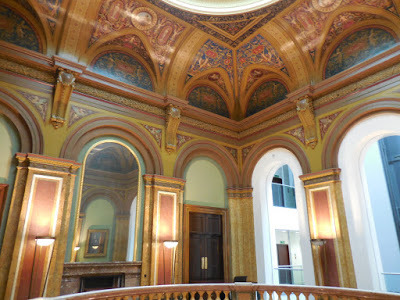
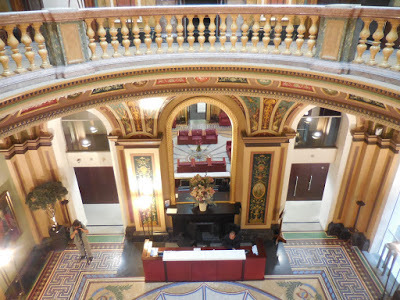
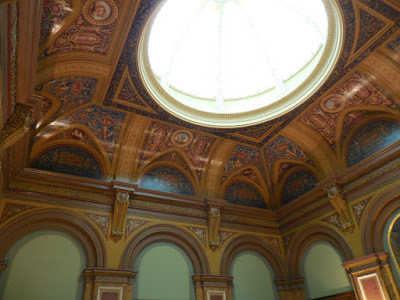
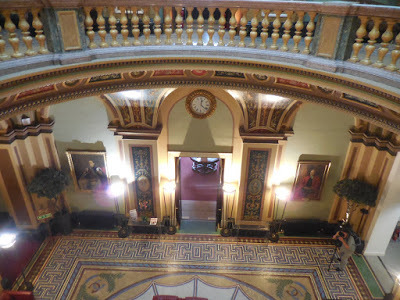
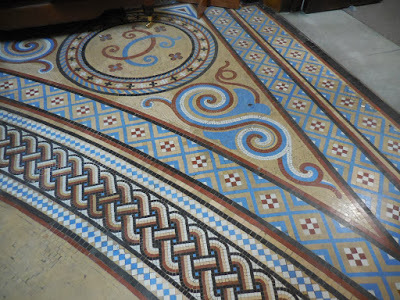
We stood on the balcony and looked across St. James Street to the famous wine dealer, Berry Brothers and Rudd.
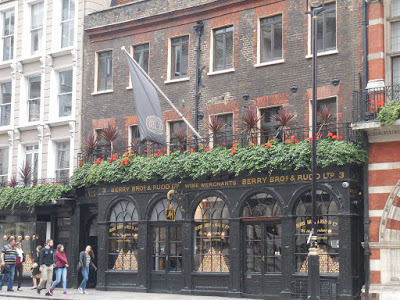
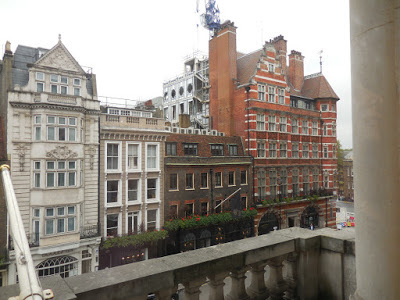 A wider view. To the far right would be St. James Palace.
A wider view. To the far right would be St. James Palace.
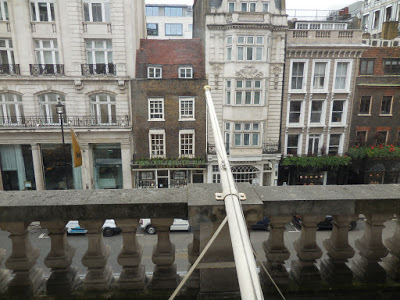
Thank you, HSBC Bank for preserving this wonderful building in St James Street.Following our feast for the eyes, we were ready for luncheon! So we went right across the street. coming next! Eating in Pickering Place - yummaaaay.
 74 St. James Street
74 St. James Street
74 St. James's Street was the site of the old Conservative Club, now dissolved. Construction started in 1843, In 1950 it merged with the Bath Club, and was disbanded in 1981. From 1845 until 1959, the club occupied a building at 74 St James's Street.and although the club moved out a century later, the building went on to be home to McKinsey and Co. in the early 1970s, and now houses the London office of HSBC Private Bank.
Prior to the Conservative Club's occupation of the site, there stood on that corner a range of low buildings derived from the country estate of Sir William Pulteney. The original complex had been converted during the 18th century into shops, taverns and pieds-a-terre. The principal establishment on the site was the Thatched House Tavern, located in the upper stories of the shops lining St. James's Street and set back from the building line so that the roof of the one-story shops formed a balcony overlooking St. James's for the drinkers and as a vantage point for watching special events, such as the Duke of York's funeral procession.

The tavern was much frequented by clubs and societies: the Society of Dilettanti, the Noblemen and Gentlemen's Catch Club and the Royal Yacht Squadron, to name a few. A narrow lane at right angles to St. James's, running through the middle of the site, gave access by a side door to the tavern and led on through to a small court (Thatched House Court) behind it. The Court was of small by pretty houses providing London apartments for people of fashion such as Edward Gibbon, who lived there until his death in 1894.
The new building built on the site by the Conservative Club at a cost of twenty nine thousand pounds was completed in 1845. The proportions of the saloon were injured in 1951 by the removal of the grand staircase, which led out of the middle door
 The approach hardly prepared us for the colorful and amazing craftsmanship of the interior.
The approach hardly prepared us for the colorful and amazing craftsmanship of the interior.







The series of portrait medallions honor the great artists and writers of Britain.







 Could you get any work done under this ceiling? I think I would spend my time admiring the workmanship.
Could you get any work done under this ceiling? I think I would spend my time admiring the workmanship. The inevitable mix of modern work areas with Victorian surroundings.
The inevitable mix of modern work areas with Victorian surroundings.




We stood on the balcony and looked across St. James Street to the famous wine dealer, Berry Brothers and Rudd.

 A wider view. To the far right would be St. James Palace.
A wider view. To the far right would be St. James Palace.
Thank you, HSBC Bank for preserving this wonderful building in St James Street.Following our feast for the eyes, we were ready for luncheon! So we went right across the street. coming next! Eating in Pickering Place - yummaaaay.
Published on May 16, 2016 00:00
May 13, 2016
LOOSE IN LONDON: QUEEN ALEXANDRA'S PET CEMETERY
During Open House Weekend, Victoria and I visited Marlborough House.


For the history of Marlborough House, see Victoria's post about her visit there in 2011 and our post from Monday, May 9, 2016.
from London Gardens Online :
Marlborough House is a former 'town mansion and genuine `hotel particulier' of 1707-11' built to a design of Sir Christopher Wren, which still possesses much of the extent of its original garden. It was commissioned by the first Duke of Marlborough but the idea for a town house was his Duchess Sarah's. She secured the lease of the site from Queen Anne and chose Wren in preference to Sir John Vanbrugh as architect, although she fell out with Wren during construction and supervised the completion of the house herself. She laid the foundation stone in 1709 and it was completed in 1711, the actual design probably drawn by Wren's son under his father's supervision. Sarah died here in 1744, and the Dukes of Marlborough had the house until 1817, after which it was given as the London home to Princess Charlotte and Prince Leopold of Saxe-Coburg-Saalfeld. After Charlotte's death Prince Leopold continued to use Marlborough House until he became King of the Belgians in 1831, the same year of William IV's accession to the throne, whose consort Queen Adelaide was granted the house for life in the event of widowhood.
The Queen Dowager continued to spend time here after the King's death and gave a wedding banquet for Queen Victoria and Prince Albert. After Queen Adelaide's death it was settled on the Prince of Wales, later Edward VII as his residence from the age of 18. At that time it was substantially altered by Sir James Pennethorne, chief architect at the Office of Works. It continued in royal occupation into the 1950s, by the Duke of York later George V, Edward VII's widow Queen Alexandra, and finally Queen Mary on the death of George V came to Marlborough House in 1936 and died here in 1953. In 1959 Elizabeth II placed it at the disposal of the Government as a Commonwealth Centre, which it became in 1962, becoming the headquarters of the Commonwealth Secretariat in 1965.
The House was wonderful, but the thing I really wanted to see was Queen Alexandra's pet cemetery. Regular readers of this blog may recall that on a previous trip to England I'd gone to Oatlands near Windsor in order to view the pet cemetery of Frederica, Duchess of York.

At Marlborough House, a leafy pedestrian lane leads one to the pet cemetery.

That Queen Alexandra loved her pets is beyond doubt, but there's also photographic proof of the fact to be seen on several of the markers in the cemetery.


Whilst not all the graves are adorned with photographs, all are evidence of grief over the loss of a beloved friend.


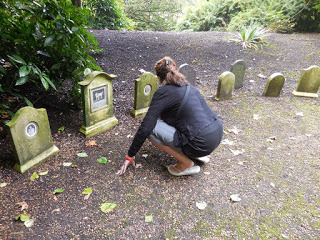 Kristine gets a closer look.
Kristine gets a closer look.

Even the bunnies were given dignified burials.
But perhaps the most famous of those buried here is Ceasar, owned by Queen Alexandra's husband, King Edward VII.

From The College of St. George website:
At the foot of the tomb of Edward VII in St George’s Chapel can be seen the curled up figure of Caesar, a wire-haired fox terrier and the King’s favourite dog.Caesar was Edward VII’s constant companion, following him everywhere and travelling the world with him. His collar read “I am Caesar. I belong to the King”. Such was Edward’s love of his scruffy sidekick that he had Faberge make a trinket of Caesar, which was given to Queen Alexandra. Caesar might not have been popular with everyone, but Edward loved him.
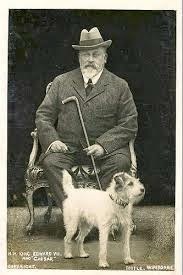
On Edward VII’s death in 1910, Caesar is reported to have been heartbroken, barely eating or drinking, searching the rooms for his missing master.
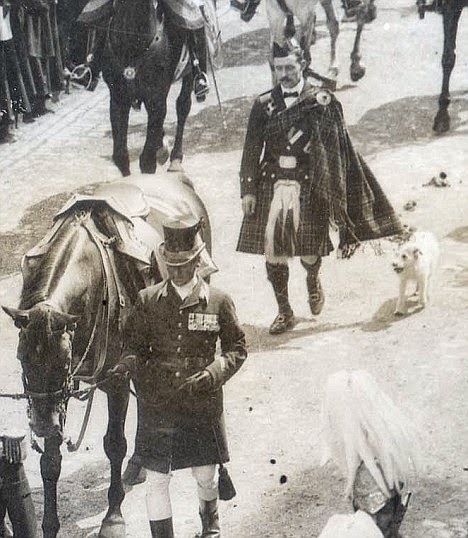
The world was moved by photographs of the little dog, accompanied by Edward’s favourite horse, trotting faithfully behind his master through the streets of London in the funeral procession, together at the last as they had always been. Caesar even preceded the crowned heads of Europe, including Kaiser Wilhelm, an insult which it has been claimed helped fuel the animosity which led to the First World War.Caesar went to live with Queen Alexandra, and continued his travels with her before eventually dying in 1914. She wrote for his epitaph “Our beloved Caesar who was the King’s Faithful and Constant Companion until Death and My Greatest Comforter in my Loneliness and Sorrow for Four Years after. Died April 18th 1914.″
If you've enjoyed this post, you may be interested in the Libby Hall Collection, an online gallery of historic photos of London dogs from all walks of life - a truly fascinating site.

The actress Ellen Terry with her canine companions.
Published on May 13, 2016 00:00
May 11, 2016
THE HUDSON RIVER SCHOOL
JUST A BRIEF BREAK FROM ALL THINGS ENGLISH....
A collection of lovely paintings from the New York historical Society just closed at the Milwaukee Art Museum. Victoria here, to tell you a little bit about them.
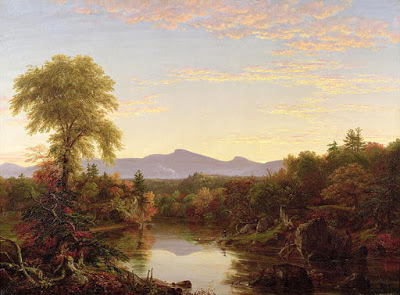 Thomas Cole, Catskill Creek, N.Y. 1845
Thomas Cole, Catskill Creek, N.Y. 1845
The group of landscape painters in 19th America which became known as the Hudson River School started by painting the lovely wilderness landscapes of the "New World" just west of the Atlantic Coast where the first European settlements grew.
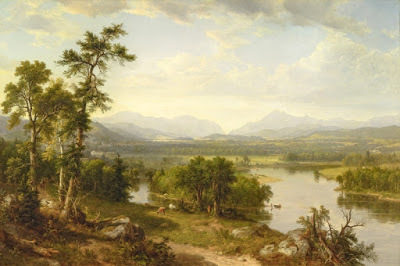 Asher Brown Durand, White Mountain Scenery, Franconia Notch, N.H., 1857
Asher Brown Durand, White Mountain Scenery, Franconia Notch, N.H., 1857
As the artists discovered more and more of the spectacular scenery, their paintings inspired more settlers and even caught the attention of the European art world.
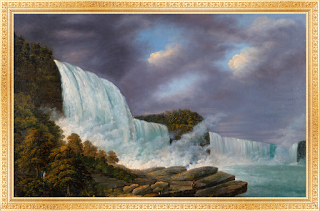 Louise Davis Minot, Niagara Falls, 1818
Louise Davis Minot, Niagara Falls, 1818
Imagine encountering this enormous waterfall on the U.S.-Canadian border for the first time. Ms. Minot wrote: "The roar deepened, the rock shook over my head, the earth trembled...It was some time before I could command my pencil."
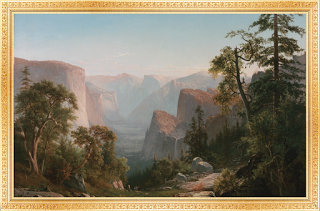 Thomas Hill, View of the Yosemite Valley, 1865
Thomas Hill, View of the Yosemite Valley, 1865
Eventually the artists reached California and its majestic mountains...as well as all the sights in between.
The five paintings by Thomas Cole in the series "Rise and Fall" trace the development and destruction of civilization, from savage nature to feeble ruins.
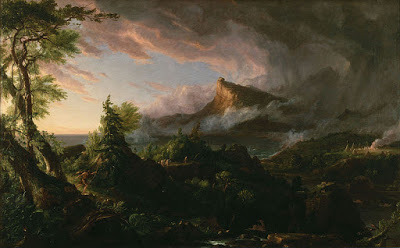 Thomas Cole, The Course of Empire: The Savage State, 1834
Thomas Cole, The Course of Empire: The Savage State, 1834
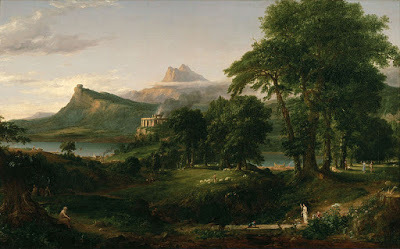 Thomas Cole, The Course of Empire: The Arcadian or Pastoral State, 1834
Thomas Cole, The Course of Empire: The Arcadian or Pastoral State, 1834
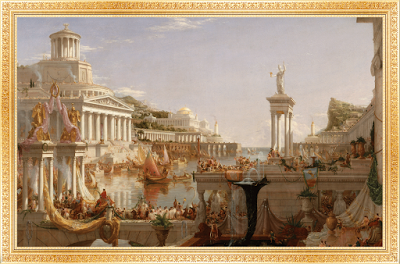 Thomas Cole, The Course of Empire: The Consummation of Empire. 1835-36
Thomas Cole, The Course of Empire: The Consummation of Empire. 1835-36
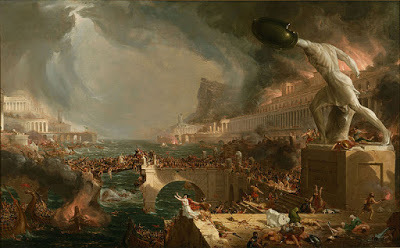 Thomas Cole, The Course of Empire: Destruction, 1836
Thomas Cole, The Course of Empire: Destruction, 1836
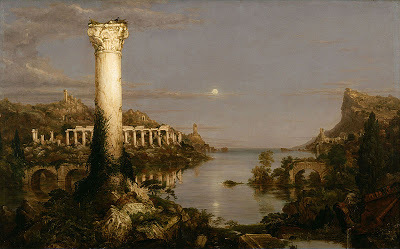 Thomas Cole, The Course of Empire: Desolation, 1836
Thomas Cole, The Course of Empire: Desolation, 1836
Here is the official description of the exhibition: "Nature and the American Vision is a landmark exhibition featuring nearly fifty masterpieces from the New-York Historical Society’s acclaimed collection of landscape paintings, the most revered in the country. In addition to the beauty and historic value of the paintings, the exhibition charts the emergence of the Hudson River School, considered the nation’s first original artistic movement, and includes iconic works by luminaries alongside rarely seen masterpieces. Rising to eminence during the mid-nineteenth century, this loosely knit group of painters, poets, and writers forged a self-consciously American artistic voice, one grounded in the exploration of the natural world as a resource for spiritual renewal and as an expression of cultural and national identity. This exhibition was organized by the New-York Historical Society and is supported by an indemnity from the Federal Council on the Arts and the Humanities.
 Milwaukee Art Museum
Milwaukee Art Museum
A collection of lovely paintings from the New York historical Society just closed at the Milwaukee Art Museum. Victoria here, to tell you a little bit about them.
 Thomas Cole, Catskill Creek, N.Y. 1845
Thomas Cole, Catskill Creek, N.Y. 1845The group of landscape painters in 19th America which became known as the Hudson River School started by painting the lovely wilderness landscapes of the "New World" just west of the Atlantic Coast where the first European settlements grew.
 Asher Brown Durand, White Mountain Scenery, Franconia Notch, N.H., 1857
Asher Brown Durand, White Mountain Scenery, Franconia Notch, N.H., 1857As the artists discovered more and more of the spectacular scenery, their paintings inspired more settlers and even caught the attention of the European art world.
 Louise Davis Minot, Niagara Falls, 1818
Louise Davis Minot, Niagara Falls, 1818Imagine encountering this enormous waterfall on the U.S.-Canadian border for the first time. Ms. Minot wrote: "The roar deepened, the rock shook over my head, the earth trembled...It was some time before I could command my pencil."
 Thomas Hill, View of the Yosemite Valley, 1865
Thomas Hill, View of the Yosemite Valley, 1865Eventually the artists reached California and its majestic mountains...as well as all the sights in between.
The five paintings by Thomas Cole in the series "Rise and Fall" trace the development and destruction of civilization, from savage nature to feeble ruins.
 Thomas Cole, The Course of Empire: The Savage State, 1834
Thomas Cole, The Course of Empire: The Savage State, 1834 Thomas Cole, The Course of Empire: The Arcadian or Pastoral State, 1834
Thomas Cole, The Course of Empire: The Arcadian or Pastoral State, 1834 Thomas Cole, The Course of Empire: The Consummation of Empire. 1835-36
Thomas Cole, The Course of Empire: The Consummation of Empire. 1835-36 Thomas Cole, The Course of Empire: Destruction, 1836
Thomas Cole, The Course of Empire: Destruction, 1836 Thomas Cole, The Course of Empire: Desolation, 1836
Thomas Cole, The Course of Empire: Desolation, 1836Here is the official description of the exhibition: "Nature and the American Vision is a landmark exhibition featuring nearly fifty masterpieces from the New-York Historical Society’s acclaimed collection of landscape paintings, the most revered in the country. In addition to the beauty and historic value of the paintings, the exhibition charts the emergence of the Hudson River School, considered the nation’s first original artistic movement, and includes iconic works by luminaries alongside rarely seen masterpieces. Rising to eminence during the mid-nineteenth century, this loosely knit group of painters, poets, and writers forged a self-consciously American artistic voice, one grounded in the exploration of the natural world as a resource for spiritual renewal and as an expression of cultural and national identity. This exhibition was organized by the New-York Historical Society and is supported by an indemnity from the Federal Council on the Arts and the Humanities.
 Milwaukee Art Museum
Milwaukee Art Museum
Published on May 11, 2016 00:00
May 9, 2016
OPEN CITY DAYS: MARLBOROUGH HOUSE
VISITING MARLBOROUGH HOUSE
Walking from Carlton House Terrace along Pall Mall
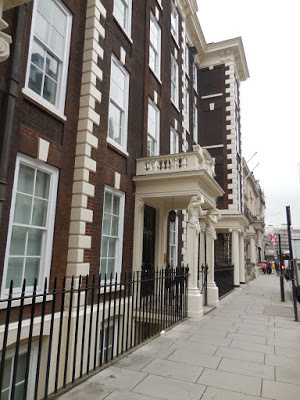 Schomberg House
Schomberg House
This building housed the 3rd Duke of Schomberg in the late 17th century, a General working for King William of Orange. Later the building was divided into three separate residences; it had a varied history, to say the least.
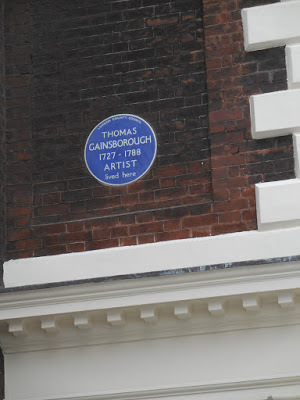 Among the luminaries who lived here were Thomas Gainsborough and fellow artist Richard Cosway.
Among the luminaries who lived here were Thomas Gainsborough and fellow artist Richard Cosway.
One of the residences was, for a time, the Temple of Health and Hymen where a Scottish doctor rented out a "celestial bed" said to cure infertility. Eventually closed by police, it was later a draper's, and eventually part of the War Office, along with other mansions along Pall Mall.
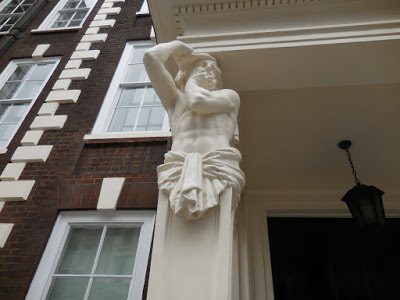 The decorative features of Schomberg House are made of Coade Stone, a popular material for buildings in the early 19th century. Currently, only the facade exists with modern structures behind it.
The decorative features of Schomberg House are made of Coade Stone, a popular material for buildings in the early 19th century. Currently, only the facade exists with modern structures behind it.
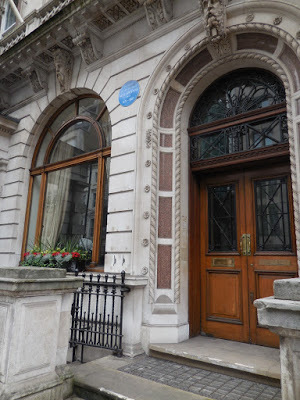
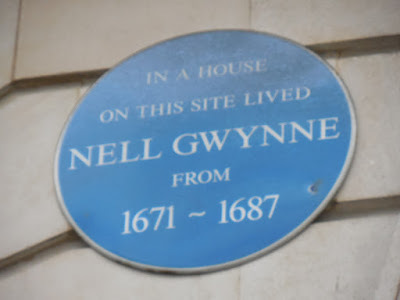 Another well-known resident lived nearby.
Another well-known resident lived nearby.
Approaching Marlborough House from the rear:
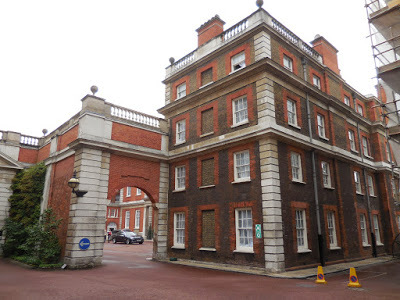
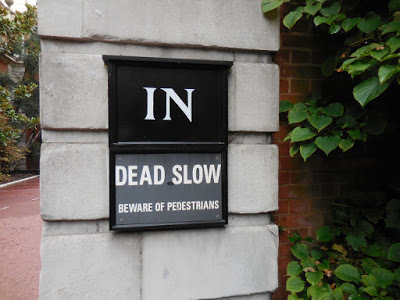
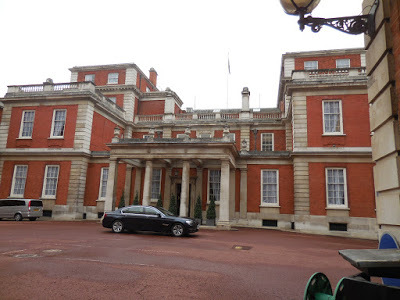
Marlborough House was built for the Duke of Marlborough in 1709–11 on the site of the St James’s Palace pheasantry. Sir Christopher Wren designed the house, though plans were drawn by his son, Christopher Wren the younger. The red Dutch bricks of the walls were ballast returning on vessels which transported soldiers to Holland to fight under the Duke of Marlborough.
Beginning about 1817, members of the royal family resided here, Edward, Prince of Wales (later Edward VII) and his wife, Alexandra of Denmark moved in in the 1860's, and the society that assembled around this couple became known as the Marlborough House Set.
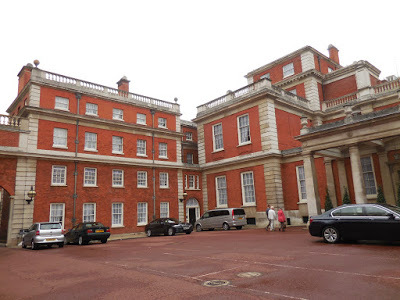
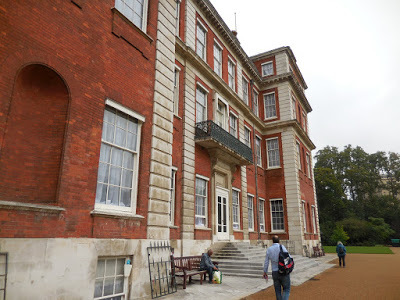
In 1959 Marlborough House became the Commonwealth Secretariat and the Commonwealth Foundation. Sadly, no photos were allowed inside, but the central hall can be found on the internet.
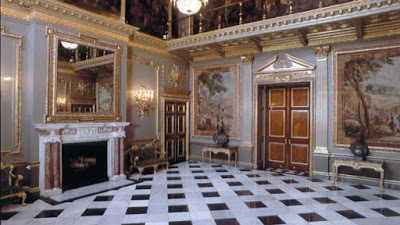 Marlborough House Hall
Marlborough House Hall
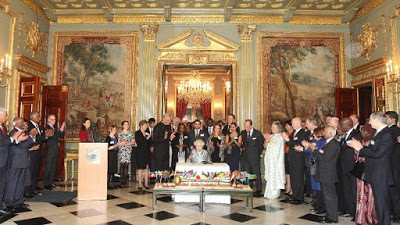 Queen Elizabeth presides at a Commonwealth Meeting
Queen Elizabeth presides at a Commonwealth Meeting
The Garden facade of this noble house!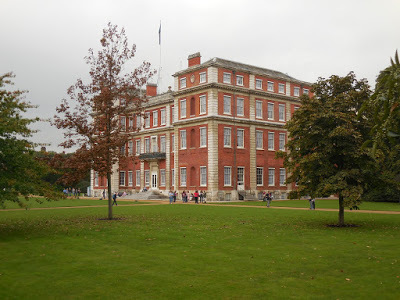
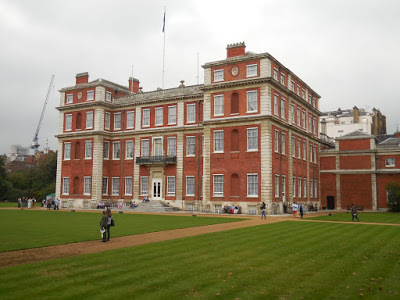
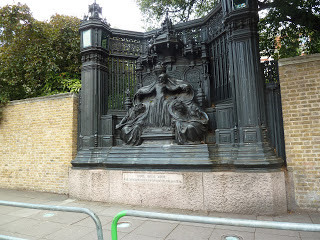 On the Wall along Marlborough Road, stands the Memorial to Queen Alexandra, completed in 1932 by Sir Alfred Gilbert.
On the Wall along Marlborough Road, stands the Memorial to Queen Alexandra, completed in 1932 by Sir Alfred Gilbert.
Coming next, Kristine visits the Pet Cemetery in the Marlborough House Garden.
Walking from Carlton House Terrace along Pall Mall
 Schomberg House
Schomberg HouseThis building housed the 3rd Duke of Schomberg in the late 17th century, a General working for King William of Orange. Later the building was divided into three separate residences; it had a varied history, to say the least.
 Among the luminaries who lived here were Thomas Gainsborough and fellow artist Richard Cosway.
Among the luminaries who lived here were Thomas Gainsborough and fellow artist Richard Cosway. One of the residences was, for a time, the Temple of Health and Hymen where a Scottish doctor rented out a "celestial bed" said to cure infertility. Eventually closed by police, it was later a draper's, and eventually part of the War Office, along with other mansions along Pall Mall.
 The decorative features of Schomberg House are made of Coade Stone, a popular material for buildings in the early 19th century. Currently, only the facade exists with modern structures behind it.
The decorative features of Schomberg House are made of Coade Stone, a popular material for buildings in the early 19th century. Currently, only the facade exists with modern structures behind it.
 Another well-known resident lived nearby.
Another well-known resident lived nearby.Approaching Marlborough House from the rear:



Marlborough House was built for the Duke of Marlborough in 1709–11 on the site of the St James’s Palace pheasantry. Sir Christopher Wren designed the house, though plans were drawn by his son, Christopher Wren the younger. The red Dutch bricks of the walls were ballast returning on vessels which transported soldiers to Holland to fight under the Duke of Marlborough.
Beginning about 1817, members of the royal family resided here, Edward, Prince of Wales (later Edward VII) and his wife, Alexandra of Denmark moved in in the 1860's, and the society that assembled around this couple became known as the Marlborough House Set.


In 1959 Marlborough House became the Commonwealth Secretariat and the Commonwealth Foundation. Sadly, no photos were allowed inside, but the central hall can be found on the internet.
 Marlborough House Hall
Marlborough House Hall Queen Elizabeth presides at a Commonwealth Meeting
Queen Elizabeth presides at a Commonwealth Meeting The Garden facade of this noble house!


 On the Wall along Marlborough Road, stands the Memorial to Queen Alexandra, completed in 1932 by Sir Alfred Gilbert.
On the Wall along Marlborough Road, stands the Memorial to Queen Alexandra, completed in 1932 by Sir Alfred Gilbert.Coming next, Kristine visits the Pet Cemetery in the Marlborough House Garden.
Published on May 09, 2016 00:00
May 6, 2016
OPEN CITY DAYS: THE BRITISH ACADEMY
IN CARLTON TERRACE, occupying Numbers 10 and 11, the British Academy is the UK's national body for the humanities and social sciences – the study of peoples, cultures and societies, past, present and future. It funds fellowships, research grants, awards, and charitable activities, including British Film Awards.
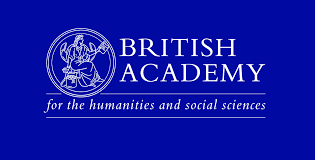
The British Academy website is here.
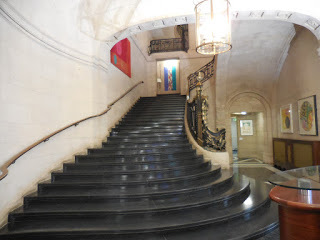
On the ground floor for the Open City visitors, the BA displayed an exhibition of photos from the history of the house. Here is their explanation of the exhibition:
"From 1830 until 1920, 10 Carlton House Terrace was the London Home of the Ridley family. The Ridleys were a wealthy Northumberland family who had made their fortune in Coal mining. When war broke out, in 1914, Lady Ridley decided to open up her London home as a hospital for wounded officers.
Affiliated with Queen Alexandria’s Military Hospital in Milbank, it was principally a convalescent hospital. It was staffed by a house doctor, trained nurses, and members of London/52 Voluntary Aid Detachment (VADs). According to newspaper clippings of the time, it quickly established itself as ‘by far the most fashionable hospital for officers in the war'; and it soon became a popular sight-seeing spot. One report from the period states that ‘every morning an interested crowd collects to see the public shaving of the wounded soldiers, who are so comfortably situated in the temporary hospitals which are perched on the top of terraces behind Carlton House Terraces.’
In 1918, Lady Ridley was made a Dame in recognition of her work as donor and administrator of the Hospital. Upon the hospital’s closure in February 1919, she wrote to express her gratitude to those who had worked there: ‘It is largely owing to the devoted band of VADs that the hospital achieved such a standard of efficiency and comfort, and was and was able to bring such a great measure of relief and happiness to those who suffered so much in the War.’"
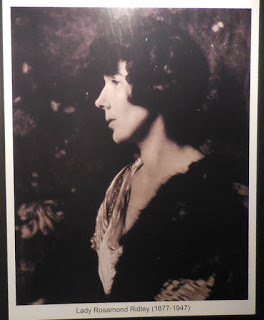 Lady Rosamund Ridley (1877-1947)
Lady Rosamund Ridley (1877-1947)
Lady Ridley was a cousin of Sir Winston Churchill and wife of Matthew White Ridley, 1st Viscount Ridley. At the beginning of the 20th century, the Ridleys redecorated the house in the French style and installed the grand staircase.
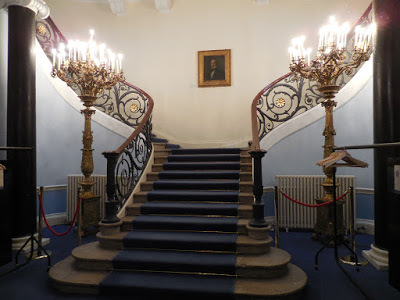 French Staircase
French Staircase
Beginning in 1914 with 25 beds, Lady Ridley expanded her hospital to 60 beds by 1917. One volunteer, Aileen Maunsell, became a nurse and worked at Lady Ridley's Hospital where she also entertained the patients by playing concerts for them. Eventually she married 2nd Lt. Gell in 1920.
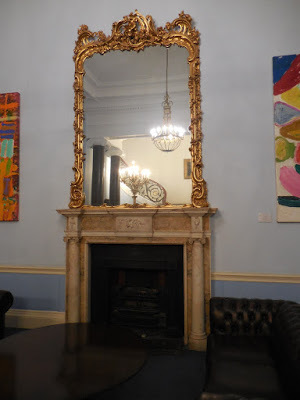
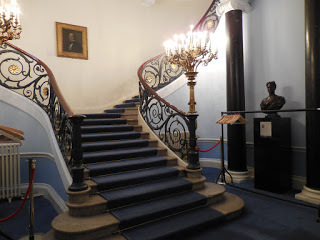
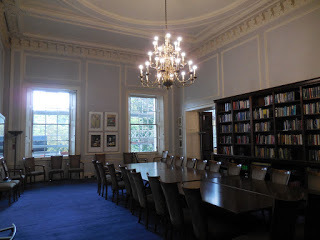
Lady Ridley’s Hospital stayed open for several months after the war ended. In later years, the building was the residence of Lord Monson, four-time Prime Minister William Gladstone (1856 to 1875), and the Guinness family, before becoming home to the British Academy in 1998.
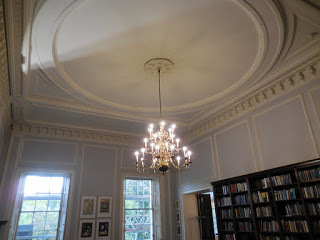
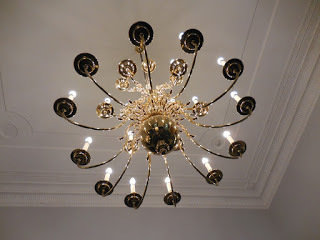
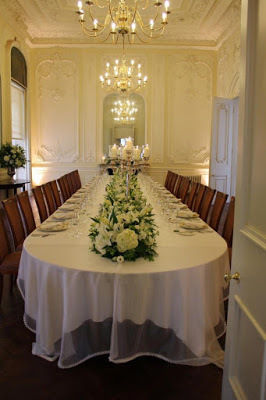 The music room from the wedding venue page
The music room from the wedding venue page
The British Academy was established in 1902; a fellowship of more than 900 leading scholars spanning all disciplines across the humanities and social sciences. it is an independent registered charity. The exterior of the building 10-11 Carlton House Terrace can be seen on the popular BBC's Sherlock,as the Diogenes Club.
Our next goal was a stroll down Pall Mall to Marlborough House...

The British Academy website is here.

On the ground floor for the Open City visitors, the BA displayed an exhibition of photos from the history of the house. Here is their explanation of the exhibition:
"From 1830 until 1920, 10 Carlton House Terrace was the London Home of the Ridley family. The Ridleys were a wealthy Northumberland family who had made their fortune in Coal mining. When war broke out, in 1914, Lady Ridley decided to open up her London home as a hospital for wounded officers.
Affiliated with Queen Alexandria’s Military Hospital in Milbank, it was principally a convalescent hospital. It was staffed by a house doctor, trained nurses, and members of London/52 Voluntary Aid Detachment (VADs). According to newspaper clippings of the time, it quickly established itself as ‘by far the most fashionable hospital for officers in the war'; and it soon became a popular sight-seeing spot. One report from the period states that ‘every morning an interested crowd collects to see the public shaving of the wounded soldiers, who are so comfortably situated in the temporary hospitals which are perched on the top of terraces behind Carlton House Terraces.’
In 1918, Lady Ridley was made a Dame in recognition of her work as donor and administrator of the Hospital. Upon the hospital’s closure in February 1919, she wrote to express her gratitude to those who had worked there: ‘It is largely owing to the devoted band of VADs that the hospital achieved such a standard of efficiency and comfort, and was and was able to bring such a great measure of relief and happiness to those who suffered so much in the War.’"
 Lady Rosamund Ridley (1877-1947)
Lady Rosamund Ridley (1877-1947)Lady Ridley was a cousin of Sir Winston Churchill and wife of Matthew White Ridley, 1st Viscount Ridley. At the beginning of the 20th century, the Ridleys redecorated the house in the French style and installed the grand staircase.
 French Staircase
French Staircase Beginning in 1914 with 25 beds, Lady Ridley expanded her hospital to 60 beds by 1917. One volunteer, Aileen Maunsell, became a nurse and worked at Lady Ridley's Hospital where she also entertained the patients by playing concerts for them. Eventually she married 2nd Lt. Gell in 1920.



Lady Ridley’s Hospital stayed open for several months after the war ended. In later years, the building was the residence of Lord Monson, four-time Prime Minister William Gladstone (1856 to 1875), and the Guinness family, before becoming home to the British Academy in 1998.


 The music room from the wedding venue page
The music room from the wedding venue pageThe British Academy was established in 1902; a fellowship of more than 900 leading scholars spanning all disciplines across the humanities and social sciences. it is an independent registered charity. The exterior of the building 10-11 Carlton House Terrace can be seen on the popular BBC's Sherlock,as the Diogenes Club.
Our next goal was a stroll down Pall Mall to Marlborough House...
Published on May 06, 2016 00:00
Kristine Hughes's Blog
- Kristine Hughes's profile
- 6 followers
Kristine Hughes isn't a Goodreads Author
(yet),
but they
do have a blog,
so here are some recent posts imported from
their feed.



